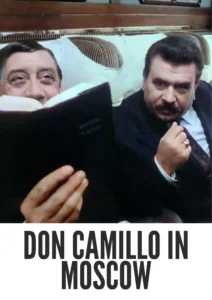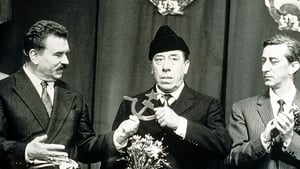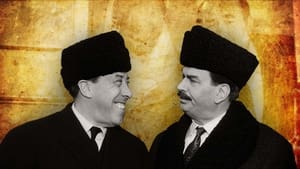Contact: info@alwanfilm.com
Video Sources 0 Views
Synopsis
Review: Don Camillo in Moscow 1965 Colorized – A Classic Comedy in a New Light

Introduction
The 1960s were a golden era for European cinema, producing films that ranged from poignant dramas to delightful comedies. Among the latter is “Don Camillo in Moscow” (1965), the fifth film in the beloved Don Camillo series. Directed by Luigi Comencini, this film takes the iconic rivalry between the good-natured yet stubborn Catholic priest, Don Camillo, and the equally headstrong Communist mayor, Peppone, to the unexpected setting of Soviet Russia. With its recent release in an early colored version, the film has once again captured the attention of audiences and critics alike. This article will explore the impact of colorization on “Don Camillo in Moscow,” its significance in the context of film history, and the lasting legacy of this charming cinematic gem.
Check The Full Colorized Movies List
Check Our Colorized Movies Trailer Channel
Understanding Don Camillo in Moscow 1965 Colorized: Director, Cast, and Genre
“Don Camillo in Moscow” (1965) stands as a testament to the enduring appeal of the Don Camillo series, which began in 1952 with “The Little World of Don Camillo.” Directed by Luigi Comencini, a master of Italian comedy, the film retains the charm and wit that made the earlier entries so beloved. Comencini, known for his ability to blend humor with social commentary, brings a unique perspective to the series, emphasizing the cultural clash between East and West during the Cold War era.
The film stars the iconic French actor Fernandel as Don Camillo, whose expressive face and comedic timing bring the character to life. Opposite him is the equally charismatic Gino Cervi as Peppone, the Communist mayor with a heart of gold. Together, their on-screen chemistry fuels the narrative, delivering both laughs and thoughtful reflections on political and ideological divides.
Genre-wise, “Don Camillo in Moscow” is a comedy, but it’s more than just a light-hearted romp. It blends elements of satire, social commentary, and political farce, reflecting the complex realities of its time while maintaining an accessible, entertaining approach.
Exploring the World of Don Camillo in Moscow 1965 Colorized: Plot and Characters
The plot of “Don Camillo in Moscow” takes the familiar rivalry between Don Camillo and Peppone to a new level, transporting the characters from their small Italian village to the vast, unfamiliar landscape of Soviet Russia. The story begins with Peppone winning a local election and being invited to Moscow on an official trip. Don Camillo, ever the rival and ever curious, manages to join the delegation in disguise, posing as one of Peppone’s supporters.
As the group navigates the cultural and political landscape of the USSR, hilarity ensues. Don Camillo’s encounters with Soviet officials, his attempts to maintain his religious duties in an atheistic regime, and the inevitable clashes with Peppone all contribute to the film’s comedic tension. Despite their differences, the trip ultimately reinforces the unlikely friendship between the two protagonists, underscoring themes of unity and understanding across ideological divides.
The film’s supporting characters add further layers of humor and intrigue. From the bumbling local Communist officials in Moscow to the Italian villagers left behind, each character contributes to the film’s exploration of cultural misunderstandings and the universality of human experience.
The Art of Film Colorization
Film colorization is the process of adding color to black-and-white movies, a technique that has evolved significantly since its inception. In the early days, colorization was done manually, frame by frame, a labor-intensive process that often resulted in unnatural, pastel-like hues. However, with advancements in digital technology, modern colorization can produce vibrant, realistic colors that enhance the viewing experience.
Despite these advancements, the practice remains controversial. Purists argue that colorization can alter the filmmaker’s original vision, changing the mood and tone of the film. Proponents, however, believe that colorization can make classic films more accessible to modern audiences, who may be less inclined to watch black-and-white movies.
Early Colored Films: A Brief History
The journey of early colored films is a fascinating chapter in the history of cinema. Before the advent of natural color film processes like Technicolor, filmmakers employed various methods to bring color to the screen. These included hand-tinting, where each frame was colored by hand, and stencil coloring, which involved using stencils to apply color to specific areas of the film.
The first experiments with color in cinema date back to the early 20th century, with films like “A Trip to the Moon” (1902) featuring hand-painted sequences. The introduction of Technicolor in the 1930s marked a significant leap forward, allowing for full-color films that could be produced on a larger scale. However, colorization of existing black-and-white films remained relatively rare until the late 20th century, when digital technology made the process more feasible.
Don Camillo in Moscow 1965 and Its Early Colored Version
The decision to release “Don Camillo in Moscow” (1965) in a colorized format is both an artistic and commercial one. For fans of the original series, this version offers a new way to experience the film, bringing its characters and settings to life in a vibrant new palette. The Italian countryside, the bustling streets of Moscow, and the expressive faces of the characters take on a new dimension when viewed in color.
However, this colorization also prompts a reevaluation of the film’s original aesthetic. The original black-and-white cinematography of “Don Camillo in Moscow” was carefully crafted to emphasize contrasts—between light and dark, rich and poor, East and West. The decision to colorize the film thus alters these contrasts, offering a different visual experience that may appeal to some viewers while alienating others.
The colorized version also highlights certain details that may have been less noticeable in the original. For instance, the vibrant costumes of the Soviet officials and the rustic charm of the Italian village are given new life, adding layers of visual storytelling that were previously subdued.
The Debate Over Film Colorization
The debate over film colorization is a long-standing one, with passionate arguments on both sides. Critics of colorization argue that it can distort the original artistic intent of the filmmakers, stripping the film of its historical context and aesthetic integrity. They contend that black-and-white cinematography is a deliberate artistic choice, one that enhances the narrative through its use of shadow, contrast, and texture.
Supporters of colorization, on the other hand, argue that it can make classic films more accessible to contemporary audiences, who may be more accustomed to color films. They also point out that colorization can revive interest in older films, bringing them to the attention of younger viewers who might otherwise overlook them.
In the case of “Don Camillo in Moscow,” the colorization offers a fresh take on a beloved classic, but it also raises questions about the preservation of cinematic history. Is the colorized version a tribute to the original, or does it risk overshadowing the black-and-white version that so many fans cherish?
Examining Don Camillo in Moscow 1965 as an Early Colored Film
Viewing “Don Camillo in Moscow” in its early colored incarnation provides a unique perspective on the film’s narrative and thematic elements. The vibrant colors bring new energy to the film, enhancing the comedic moments and highlighting the cultural contrasts that are central to the story.
For instance, the scenes set in Moscow, with their stark Soviet architecture and austere color schemes, contrast sharply with the warm, earthy tones of the Italian countryside. This visual juxtaposition reinforces the cultural and ideological differences between the characters, adding depth to the film’s satirical commentary on the Cold War era.
However, the colorization also changes the film’s mood in subtle ways. The original black-and-white version has a certain timeless quality, with its monochromatic palette lending an air of nostalgia and simplicity. The colorized version, by contrast, feels more immediate and contemporary, which may alter the viewer’s perception of the film’s setting and themes.
Influence and Legacy: Don Camillo in Moscow 1965 Colorized’s Impact on Cinema
“Don Camillo in Moscow” (1965) may not have had the same global impact as some of its contemporaries, but its influence on European cinema and popular culture is undeniable. The Don Camillo series as a whole has left a lasting legacy, with its unique blend of humor, social commentary, and character-driven storytelling.
The film’s portrayal of the Cold War from a comedic perspective was innovative for its time, offering a light-hearted take on the tensions between East and West. This approach paved the way for other films and television shows that used humor to address serious political and social issues.
Moreover, the characters of Don Camillo and Peppone have become cultural icons, representing the enduring appeal of stories about unlikely friendships and the clash of ideologies. Their dynamic has inspired countless adaptations, remakes, and homages, cementing their place in the pantheon of classic film characters.
Director’s Cinematic Legacy: Beyond Don Camillo in Moscow 1965 Colorized
Luigi Comencini, the director of “Don Camillo in Moscow,” was one of Italy’s most beloved filmmakers, known for his ability to blend comedy with poignant social observations. His work often focused on the lives of ordinary people, exploring the challenges and joys of everyday life with warmth and humor.
Comencini’s films, including “Bread, Love and Dreams” (1953) and “Everybody Go Home” (1960), are celebrated for their humanistic approach and their ability to capture the spirit of post-war Italy. “Don Camillo in Moscow” fits within this tradition, using humor to explore the complexities of cultural and political identity.
Comencini’s influence extends beyond his own filmography, as his work has inspired generations of Italian filmmakers. His approach to storytelling—combining sharp social critique with a deep empathy for his characters—remains a hallmark of Italian cinema.
Themes Explored in Don Camillo in Moscow 1965 Colorized
“Don Camillo in Moscow” explores several themes that resonate across time and place. The film delves into the nature of ideological conflict, using the rivalry between Don Camillo and Peppone to explore the broader tensions between communism and Catholicism, East and West.
At the heart of the film is the theme of friendship. Despite their political differences, Don Camillo and Peppone share a deep bond, rooted in mutual respect and a shared love for their community. This theme of unity amid division is particularly poignant in the context of the Cold War, offering a hopeful message about the power of human connection.
The film also addresses the theme of cultural exchange. The journey to Moscow allows both Don Camillo and Peppone to confront their preconceived notions about the Soviet Union, leading to moments of self-reflection and growth. This theme is underscored by the film’s comedic tone, which highlights the absurdity of rigid ideological thinking.
Reception and Controversy Surrounding Don Camillo in Moscow 1965 Colorized
Upon its release, “Don Camillo in Moscow” was met with mixed reviews. While fans of the series appreciated the familiar humor and character dynamics, some critics were less enthusiastic about the film’s shift in setting and tone. The early colored version has sparked similar debates, with some viewers welcoming the new visual experience and others questioning its necessity.
The controversy surrounding the colorization echoes broader debates about the preservation of cinematic history. While some argue that the colorized version introduces the film to a new generation of viewers, others fear that it may overshadow the original black-and-white version, which has its own unique charm and historical significance.
Where to Watch Don Camillo in Moscow 1965 Colorized Online
For those eager to watch “Don Camillo in Moscow” (1965), the film is available on various streaming platforms, both in its original black-and-white version and the early colored version. Popular platforms such as Amazon Prime, Apple TV, and Criterion Channel offer access to this classic comedy, ensuring that it remains accessible to audiences around the world.
Additionally, the film is available for purchase on DVD and Blu-ray, with some editions featuring both versions, allowing viewers to compare and contrast the different visual approaches.
FAQs About Don Camillo in Moscow 1965 Colorized
Q: Who directed “Don Camillo in Moscow”?
A: “Don Camillo in Moscow” was directed by Luigi Comencini, a prominent Italian filmmaker known for his work in the comedy genre.
Q: Is “Don Camillo in Moscow” historically accurate?
A: While the film is set during the Cold War and reflects the tensions of that era, it is primarily a work of fiction and should not be viewed as a historically accurate portrayal of Soviet Russia or the Italian Communist Party.
Q: What is the significance of the film’s colorization?
A: The colorization of “Don Camillo in Moscow” offers a new way to experience the film, bringing its settings and characters to life in a vibrant new palette. However, it also raises questions about the preservation of the film’s original aesthetic.
Conclusion
“Don Camillo in Moscow” (1965) remains a delightful entry in the Don Camillo series, blending humor, social commentary, and political satire in a way that continues to resonate with audiences. The early colored version offers a fresh perspective on this classic film, highlighting the vibrant contrasts between the Italian and Soviet settings and adding a new layer of visual storytelling.
While the debate over colorization continues, one thing is clear: “Don Camillo in Moscow” is a film that transcends its time, offering timeless insights into the nature of friendship, ideological conflict, and cultural exchange. Whether viewed in black-and-white or color, this cinematic gem remains a testament to the enduring power of comedy and the universal appeal of its beloved characters. As we reflect on the film’s legacy, we are reminded of the importance of preserving and celebrating the rich history of cinema, in all its forms.













